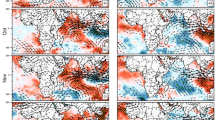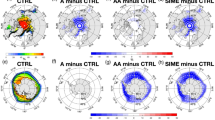Abstract
The results of four versions of IAP/LASG Global Ocean-Atmosphere-Land System Model (GOALS) are analyzed separately over the oceans and over continents, and compared with observed data. Some fundamental atmospheric variables including surface air temperature (SAT), sea level pressure (SLP) and precipitation are examined to evaluate the ability of the GOALS model to simulate the contemporary climate and climate variability. In general, all four versions of the GOALS model are capable of reproducing the main features of the mean state and seasonal variation of the observed climate with reasonable accuracy. The evaluation also reveals some weakness of the model. According to this study, we can clearly see that the essential discrepancy of global averaged SLP lies over the continents in boreal summer. The simulated higher SAT over land versus the observed is mainly due to the effect of the land surface process. It is worth noting the underestimation by simulated precipitation rates mostly appears over the oceans, yet over-land precipitation is higher in high and middle latitudes than the observed for the boreal winter.
Through intercomparisons among different versions of the model, it can be clearly seen that the incorporation of the diurnal cycle of solar radiation apparently improves the simulation of SAT, especially in the low and middle latitudes over land. Also, the introduction of the diurnal cycle shows a great improvement in precipitation in tropical continents and wintertime precipitation in high and middle latitudes. Furthermore, based on the daily flux anomaly exchange scheme (DFA), the latest version of GOALS model simulated over-ocean temperature variability is improved in the low and middle latitudes.
Having compared the standard deviation of the annual mean surface air temperature (SAT) simulated by the GOALS model to observation, it is found that all four versions of the GOALS model underestimate surface air temperature variability over both oceans and land relative to observations. Several factors that may contribute to these differences between simulated and observed temperature variability are identified.
Similar content being viewed by others
References
Gates, W. L., A. Henderson-Sellers, G. J. Boer, C. K. Follad, A. Kitoh, B. J. Mcavaney, F. Semazzi, N. Smith, A. J. Weaver, and Zeng Qingcun, 1996: Climate Models-Evaluation. Climate Change 1995: The Science of Climate Change, J. T. Houghton et al., Eds., Cambridge University Press, Cambridge, UK, 229–284.
Guo Yufu, Yu Yongqiang, and Zhang Tao, 2000: Evaluation of IAP/LASG GOALS Model. IAP Global Ocean-Atmosphere -Land System Model, Zhang, X. et al., Eds., Science Press, Beijing, 252pp.
IPCC, 1996: Climate Change 1995: The Science of Climate Change, J. T. Houghton, L. G. Meira Filho, B. A. Callander, N. Harris, A. Kattenberg, and K. Maskell, Eds., Cambridge University Press, Cambridge, UK, 572pp.
Manabe, S., and R. J Stouffer, 1996: Low-frequency variability of surface air temperature in a 1000-year integration of a coupled atmosphere-ocean-land surface model. J. Climate, 9, 376–393.
Shao H., Y. F. Qian, and Q. Q. Wang, 1998: The effects of the diurnal variation of solar radiation on climate modeling of R15L9. Plateau Meteorology, 17, 158–169 (in Chinese).
Shea, S., 1995: Climatology Atlas: 1950-1979, NCAR NCDC NOAA NICHOLSON/WMSC COADS, NCAR/TN-269+STR.
Stouffer, R. J., S. Manabe, and K. Ya. Vinnikov, 1994: Model assessment of the role natural variability in recent global warming. Nature, 367, 634–636.
WMO/ICSU, 1984: Scientific plan for the world climate research programme. WCRP publication series NO.2, WMO/TDNO. 6, P. 95.
Wu Guoxiong, Zhang Xuehong, Liu Hui, Yu Yongqiang, Jin Xiangze, Guo Yufu, Sun Shufen, Li Weiping, Wang Biao, and Shi Guangyu, 1997: Global ocean-atmosphere-land system model of LASG (GOALS/LASG) and its performance in simulation study. Quart. J. Appl. Meteor., 8, Supplement Issue, 15–28. (in Chinese).
Yu Yongqiang, 1997: The design for ocean-sea ice-atmosphere coupling scheme and numerical simulation of interdecadal climate variability. Ph.D. dissertation, Institute of Atmospheric Physics, Chinese Academy of Sciences, 130pp (in Chinese).
Yu Yongqiang, Zhang Xuehong, Liu Hui, and Jin Xiangze, 2000: Schemes for coupling the AGCM and OGCM. IAP Global Ocean-Atmosphere-Land System Model, Zhang, X. et al., Eds., Science Press, Beijing, 252pp.
Zhang Xuehong, Shi Guangyu, Liu Hui, and Yu Yongqiang, 2000: IAP Global Ocean-Atmosphere-Land System Model, Science Press, Beijing, 252pp.
Author information
Authors and Affiliations
Rights and permissions
About this article
Cite this article
Tao, Z., Yufu, G. & Guoxiong, W. Analysis of the zonal mean atmospheric climate state in IAP/LASG GOALS model simulations. Adv. Atmos. Sci. 19, 1091–1102 (2002). https://doi.org/10.1007/s00376-002-0067-z
Received:
Revised:
Issue Date:
DOI: https://doi.org/10.1007/s00376-002-0067-z




